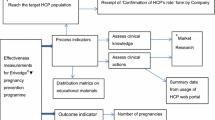Abstract
Introduction
In 2015, the European Medicines Agency (EMA) requested additional Risk Minimization Measures (RMM), consisting of a Direct Healthcare Professional Communication (DHPC), a Guide for Healthcare Professionals (HCPs), and a Guide for Patients, to prevent pregnancy exposure to mycophenolate-containing medicines.
Objectives
This study assessed the effectiveness of the additional RMM for any mycophenolate-containing medicine among prescribers of these products in Europe.
Methods
A cross-sectional survey was conducted among prescribers of mycophenolate-containing medicines in five European countries via the administration of 19 questions checking knowledge levels for the key messages included in the additional RMM.
Results
Of 79,783 invitations sent to potential prescribers of mycophenolate-containing medicines, 295 HCPs accessed the survey, giving an overall response rate of 0.4% (range 0.1–8.6%). A total of 231 prescribers were included in the primary analysis. Knowledge levels for 15 questions was fair (50 to < 70%) to high (≥ 70%), and for 4 questions was poor (< 50%). Highest knowledge (≥ 75%) was for knowing that mycophenolate is contraindicated in women of childbearing potential not using highly effective contraception (80.3%) and that mycophenolate should not be routinely prescribed during pregnancy (77.5%). Lowest knowledge (≤ 30%) was for knowing that no specific mechanism of teratogenicity and mutagenicity has been identified for mycophenolate (23.4%). Less than half of HCPs reported receipt of the DHPC (42.5%) or were aware of the Guide for HCPs (32.1%) and Guide for Patients (29.7%). The most frequently reported primary source from which HCPs learned about these risks was the Summary of Product Characteristics (SmPC; 33.8%), while only 9.9% indicated the Guide for HCPs.
Conclusion
Prescribers who participated in this survey appear to be reasonably well informed about the key messages of the RMM put in place in Europe for mycophenolate-containing medicines. The relatively high knowledge levels, in spite of the low proportion of HCPs reporting receipt of the additional RMM, suggest that the SmPC may be sufficiently informing prescribers about the pregnancy risks of mycophenolate-containing medicines and actions recommended to minimize pregnancy risk. Nevertheless, Roche in consultation with EMA will continue to distribute all additional RMM.


Similar content being viewed by others
Notes
This requirement was included in the SmPC at the time the survey was conducted; however, it has been removed from the current version of the SmPC.
References
International figures on organ, tissue & hematopoietic stem cell donation & transplantation activities. In: Beatriz D-G, Rafael M (eds) Documents produced by the Council of Europe European Committee (partial agreement) on organ transplantation (CD-P-TO), 2016. Published jointly with the European Directorate for the Quality of Medicines & HealthCare of the Council of Europe (EDQM), Strasbourg, France.
CellCept Summary of Product Characteristics and Package Leaflet, 31 August 2018. https://www.ema.europa.eu/documents/product-information/cellcept-epar-product-information_en.pdf. Accessed 30 Sep 2018.
CellCept Summary of Product Characteristics and Package Leaflet, 1998. https://ec.europa.eu/health/documents/community-register/1998/199810202869/anx_2869_en.pdf. Accessed 29 Apr 2019.
European Commission. Directive 2010/84/EU of the European Parliament and of the Council of 15 December 2010 amending, as regards pharmacovigilance, Directive 2001/83/EC on the Community code relating to medicinal products for human use, 2010.
European Medicines Agency, Guideline on good pharmacovigilance practices. Module XVI—risk minimisation measures: selection of tools and effectiveness indicators, 2014. http://www.ema.europa.eu/docs/en_GB/document_library/Scientific_guideline/2017/03/WC500224576.pdf. Accessed 30 Sep 2018.
Qizilbash N. Quantitative review of survey studies to assess the effectiveness of risk minimisation; Dec 2016. https://www.ema.europa.eu/en/documents/presentation/presentation-measuring-impact-review-survey-studies-evaluate-effectiveness-additional-risk_en.pdf. Accessed 27 Mar 2019.
European Network of Centres for Pharmacoepidemiology and Pharmacovigilance (ENCePP®) EU PAS Register. www.encepp.eu/encepp_studies/indexRegister.shtlm. Examples: http://www.encepp.eu/encepp/openAttachment/fullProtocolLatest/20723 (70% threshold), http://www.encepp.eu/encepp/openAttachment/fullProtocol/20084 (80% threshold), http://www.encepp.eu/encepp/openAttachment/fullProtocolLatest/13824 (80% threshold). Accessed 20 Feb 2019.
United States Food and Drug Administration. Draft guidance: Survey Methodologies to Assess REMS Goals That Related to Knowledge (Guidance for Industry); Jan 2019. https://www.fda.gov/downloads/Drugs/GuidanceComplianceRegulatoryInformation/Guidances/UCM629742.pdf. page 6. Accessed 27 Mar 2019.
Agyemang E, Bailey L, Talbot J. Additional risk minimisation measures for medicinal products in the European Union: a review of the implementation and effectiveness of measures in the United Kingdom by one marketing authorisation holder. Pharm Med. 2017;31:101–12.
Landsberg W, Al-Dakkak I, Coppin-Renz A, et al. Effectiveness evaluation of additional risk minimization measures for adolescent use of aripiprazole in the European Union: results from a post-authorization safety study. Drug Saf. 2018. https://doi.org/10.1007/s40264-018-0662-2 (Epub ahead of print).
Davis KH, Asiimwe A, Zografos LJ, et al. Evaluation of risk-minimization activities for cyproterone acetate 2 mg/ethinyl estradiol 35 µg: a cross-sectional physician survey. Pharm Med. 2017;31(5):339–51.
Madison T, Huang K, Huot-Marchand P, et al. Effectiveness of the crizotinib therapeutic management guide in communicating risks, and recommended actions to minimize risks, among physicians prescribing crizotinib in Europe. Pharm Med. 2018;32(5):343–52.
van der Sar JM, de Vries ST, Mol PGM, on behalf of SCOPE work package 6. European healthcare professionals’ familiarity with and perceived usefulness of safety communications on medicines. http://www.scopejointaction.eu/_assets/files/WP6-HCP-Survey-Report(1).pdf. Accessed 29 Apr 2019.
Montero D. Regulatory initiatives for measuring the impact of risk minimisation measures; Dec 2016. https://www.ema.europa.eu/en/documents/presentation/presentation-regulatory-initiatives-measuring-impact-pharmacovigilance-dolores-montero_en.pdf. Accessed 7 Nov 2018.
de Vries ST, van der Sar MJM, Cupelli A, et al. Communication on safety of medicines in Europe: current practices and General Practitioners’ awareness and preferences. Drug Saf. 2017;40:729–42.
Acknowledgements
The Authors wish to acknowledge Dr. Alan Hochberg for his valuable comments during the review of the early manuscript.
Author information
Authors and Affiliations
Corresponding author
Ethics declarations
Funding
This study was sponsored by Hoffman-La Roche Ltd.
Conflict of interest
Terri Madison is an employee of Mapi, an ICON plc Company, who received funding from Hoffman-La Roche Ltd to conduct this study. Giuseppe Alvaro, Barbara Donner, Roger Mutter, and Roberto Mingrino are employees of Hoffman-La Roche Ltd which commercializes CellCept in Europe.
Ethical approval
Ethics approval for this healthcare professional survey was not required in the participating countries.
Informed consent
Although formal written informed consent was also not required, consent to participate in the survey was documented at the beginning of the survey questionnaire.
Electronic supplementary material
Below is the link to the electronic supplementary material.
Rights and permissions
About this article
Cite this article
Madison, T., Donner, B., Mutter, R. et al. Effectiveness of Risk Minimization Measures to Prevent Pregnancy Exposure to Mycophenolate-Containing Medicines in Europe. Pharm Med 33, 395–406 (2019). https://doi.org/10.1007/s40290-019-00304-0
Published:
Issue Date:
DOI: https://doi.org/10.1007/s40290-019-00304-0




